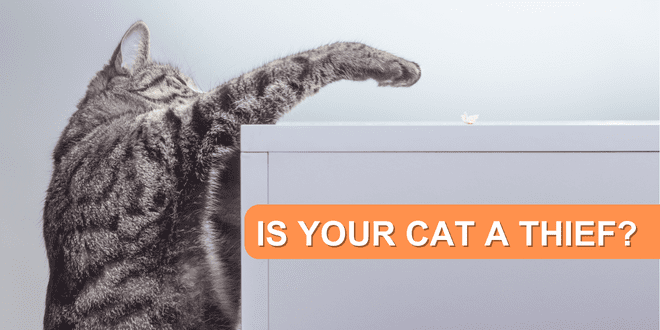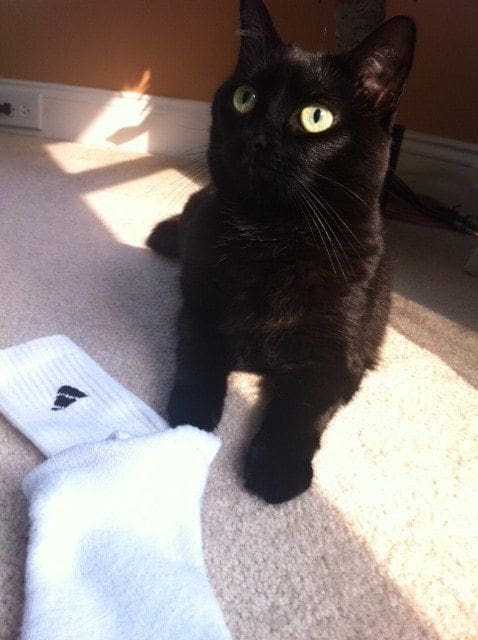
Do you have a furry, four-footed thief in your house? Has the paper clip you just set down on the desk suddenly gone missing? Or maybe it’s some food from your plate that has vanished? Your keys? A sock? Your daughter’s hair bow? If you live with a very stealthy but oh, so adorable, feline thief, you’re not alone. Many people share their lives with cats who seem to have very sticky fingers… ehh, paws. What’s the attraction?
Cats Who Steal Food
This is an obvious one to figure out. Cats are hunters and most are extremely food-motivated. You have so many enticing food aromas that pass in front of your cat’s nose several times a day and it can be hard for a hungry kitty to resist. This is especially true if your cat is on a special diet and not particularly pleased with that fact.
A contributing factor to food-stealing behavior may be the result of being fed from the dinner table. If you have offered your cat pieces of your own meal as you’re eating or you’ve rewarded him with food when he begs during the family meals, you may have put the notion in kitty’s head that he doesn’t really have to wait for someone to offer food – it can just be a help yourself option. Offering food from the table can also create an interest in a food the cat may not have otherwise been attracted to, such as sugary or salty tidbits.
Stealing food can also occur if it’s left out on an unattended counter or table. If you know you have a feline food thief, remove temptation by making sure leftovers aren’t kept out on the counter or table.
To reduce, and hopefully eliminate food-stealing behavior, consider incorporating puzzle feeders into your cat’s mealtime routine. Whether you feed wet or dry food, you can buy or construct puzzle feeders to encourage your cat to eat slowly and also enjoy some added playtime while eating. Since a cat is a hunter, the concept of working for food is very natural and a puzzle feeder is an easy way to provide that. There are many types of puzzle feeders available. Check your local pet product store or do an online search and you’ll find many options. You’ll find many products that provide varying degrees of difficulty so you should be able to find one that fits your cat’s personality and skill level.
If you feed on a schedule but there’s a huge chunk of time in-between meals, then that could also be contributing to your cat becoming a food thief. Cats have small stomachs and in an outdoor setting they would probably hunt and enjoy several small meals per day. If you only feed once or twice a day, your cat may be getting too hungry. Try dividing up the meal portion so you can feed three or four meals a day. You don’t have to increase the amount of food, just the timing of the portions.
If you think you may not be feeding enough food to your cat, get your veterinarian’s guidance. The labels on pet food packages are meant to be general guidelines. Your veterinarian can help you determine the amount to feed your cat based on current weight, age, health condition and activity level.
Cats Who Steal for Play
Some cats will steal objects just for the opportunity to play with them. Some objects are so light and can easily be pushed with the slightest touch of a paw that it’s impossible for a playful cat to pass up a chance for a little game. Before you know it though, that rubber band or paper clip ends up under the sofa or stuck under the desk.
Unfortunately, many of the objects your cat may steal out of play can be potentially harmful. If your cat plays with a rubber band, earring or other small object and decides to chew on it, the object could end up getting swallowed. Cats have backward-facing barbs on their tongues and that makes it hard for them to dislodge particular items once in the mouth. Yarn and string for instance, are particularly difficult for a cat to spit out so those items often end up getting swallowed and that can lead to a potentially life-threatening health risk.
The best solution for a cat who steals objects out of play is to 1) put tempting objects away, and, 2) offer safer alternatives. The alternatives should come in two forms. First, engage your cat in a couple of interactive play sessions per day. Interactive play therapy is a great way for you to control the action and give your cat the opportunity to really shine as the mighty hunter. Next, increase the fun factor in your home by stepping up the environmental enrichment. Give your cat something to do during the day while you’re at work so he won’t feel the need to steal in order to relieve boredom. I know you have a bunch of solo toys for your cat but they’re probably just scattered around the house gathering dust. Instead, try staging the environment so it’ll be more interesting:
- Put a fuzzy mouse inside an empty tissue box
- Leave out some open paper bags with toys or treats inside
- Place toys on cat trees
- Put some furry mice (fake ones, of course) under furniture so just their tails peek out
- Use food-dispensing balls and other puzzle feeders
- Place a cat tree near a window
- Set up some cat tunnels (make some with open paper bags)
- Install some cat shelves
- Get a great sisal-covered scratching post
- Put a bird feeder outside the window for your cat’s viewing pleasure
- Rotate toys on a weekly basis to keep them interesting
- Use catnip once or twice a week
- Set up a pet water fountain
- Play a YouTube cat entertainment video that showcases prey Cats Who Steal for Attention
Some cats may steal as an attention-getting behavior. Cat parents may reinforce this by their reactions to the behavior. Even if you reprimand the cat it’s a form of attention. If you’ve watched the cat play with the object or even participated in the game before taking it away, you’ve also reinforced the behavior. Cats are very smart animals and if your cat sees that stealing results in receiving attention, he’ll most likely repeat the behavior.
If you think your cat is stealing as an attention-getting behavior, don’t interact when you retrieve the object. Additionally, incorporate the behavior techniques mentioned previously about playtime. Give your cat an acceptable alternative to attention-seeking behavior in the form of appropriate and adequate play opportunities.
Cats Who Steal for Stress Relief

Your cat may be stealing particular objects because they provide some comfort if feeling stressed. Some cats engage in wool sucking behavior as a self-soothing mechanism so the objects stolen may include socks or other cloth items. Your cat may also steal an object that contains a family member’s scent as a way to self soothe. If you suspect the behavior is stress related, talk to your veterinarian to first make sure there isn’t an underlying medical condition, especially if your cat is engaging in wool sucking behavior. Then, use your detective skills to figure out what could be causing the stress. Keep in mind that stress triggers for a cat can seem very minor from the human’s perspective. Even something such as a change in your work schedule or the fact your oldest child just went off to college could be a potential trigger. Work on relieving the stress and increasing environmental enrichment to give your cat appropriate alternatives for the behavior. Playtime and environmental enrichment are also confidence builders because they allow the cat to engage in natural, normal behaviors such as hunting, climbing, jumping, stalking, and running. The more enrichment a cat has in the environment, the more constructive outlets he has for energy and the more positive associations made with surroundings.
Texture may also play a role in which objects your cat steals for self-soothing. The cat may be particularly attracted by a certain feel the object has when touched with paws or when it’s in his mouth.
Feline Predatory Behavior
A cat may steal objects and carry them around almost as if carrying prey. The cat may growl while walking through the house. The cat could even guard objects. If your cat displays aggression toward a family member of another companion animal because of an obsession with objects, talk to your veterinarian about a referral to a veterinary behaviorist or certified cat behavior consultant.
Need More Information
For more information on cat behavior and training, check out the best-selling books by. Pam Johnson-Bennett. Pam’s books are available at bookstores and online. We’ve included Amazon links here on our website.
If you have a question about your cat’s health, contact your veterinarian. This article is not intended as a medical diagnosis nor is it a replacement for your cat’s regular veterinary care. This article is for general information purposes only.




